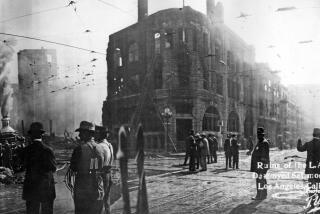Judge Refuses to Sequester Jury in New York Bombing : Trial: Panelists, who are asked not to listen to reports about Oklahoma City blast, hear testimony from witnesses in ’93 trade center explosion.
- Share via
NEW YORK — Just hours after a massive car bomb ripped apart a federal office building in Oklahoma City on Wednesday, witnesses at the domestic terrorism trial of Sheik Omar Abdel Rahman--over the objection of defense attorneys--described the horror of the 1993 bombing of New York’s World Trade Center.
Lawyers for Abdel Rahman asked federal Judge Michael B. Mukasey to sequester the jury at least through the weekend to shield them from possible taint because of the Oklahoma bombing, but the judge refused.
The sudden separation of jurors from their families could lead them to fear for their safety when such fears were unwarranted, the judge said.
Instead, Mukasey told the jury that there had been a bombing and deaths earlier in the day, and stressed “that explosion is not part of the evidence in this case.”
The judge asked the jury deciding the fate of the blind Egyptian cleric and 10 co-defendants not to listen to news reports about Oklahoma City “to the extent you can do so.”
Defense lawyers then argued that to show pictures of the trade center explosion to the jury right after the Oklahoma blast was “grave prejudice.” But they were overruled by Mukasey. Against the background of the car bombing in the American heartland, testimony about the trade center took on fresh urgency and poignancy.
“There was a very loud noise and the building heaved,” Charles J. Maikish, a top trade center official told the jury, recalling he was in the middle of signing a lease in his 35th-floor office at the twin towers when the bomb, carried into a basement garage in a rented van, went off.
Maikish said he made his way via an elevator operating under emergency power to the lobby, where he saw very heavy black smoke.
“I knew at that point we had a major event to deal with,” he said. “. . . A young lady came through the smoke. It was hazy. Her face was bleeding. The elevator operator put a rag on her face to take care of her.”
Maikish said he soon he found immense damage--fires, flooding, billowing smoke, a bomb crater half the size of a football field in the basement. Power lines were cut; high-pressure steam lines were severed; cars in the underground level where the explosion took place were burned and strewn about like toys.
“The walls had collapsed down on my car,” Maikish told the jurors, who viewed a picture of the bomb crater and listened intently.
Paul Maniscalco, a deputy chief of New York City’s emergency medical service who was the incident commander at the scene, followed Maikish to the stand.
He said every city ambulance was sent to the bombing scene, plus private ambulances--and for the first time in history it was necessary to call in ambulances from New Jersey.
“We mobilized every piece of equipment we had,” Maniscalco testified.
Abdel Rahman and his followers are charged with planning to detonate bombs at the United Nations, two tunnels linking New York with New Jersey and the Manhattan headquarters of the FBI to protest U.S. policies in the Mideast.
Prosecutors contend the attack on the trade center, which killed six people and injured more than 1,000 on Feb. 26, 1993, was an integral part of the overall scheme directed by Abdel Rahman, a vehement opponent of the government of Egypt’s President Hosni Mubarak.
Four defendants were tried last year and each was sentenced to 240 years in prison for the attack on the World Trade Center.
In February, Ramzi Ahmed Yousef, the alleged mastermind of the bombing, was captured in Pakistan and returned to the United States. Yousef’s trial date has not been set.
Last week, the indictment against him was broadened to include plans to blow up U.S. airliners in the Far East and the placement of a bomb aboard a Philippine Airlines plane last December that killed a Japanese passenger.
More to Read
Sign up for Essential California
The most important California stories and recommendations in your inbox every morning.
You may occasionally receive promotional content from the Los Angeles Times.










